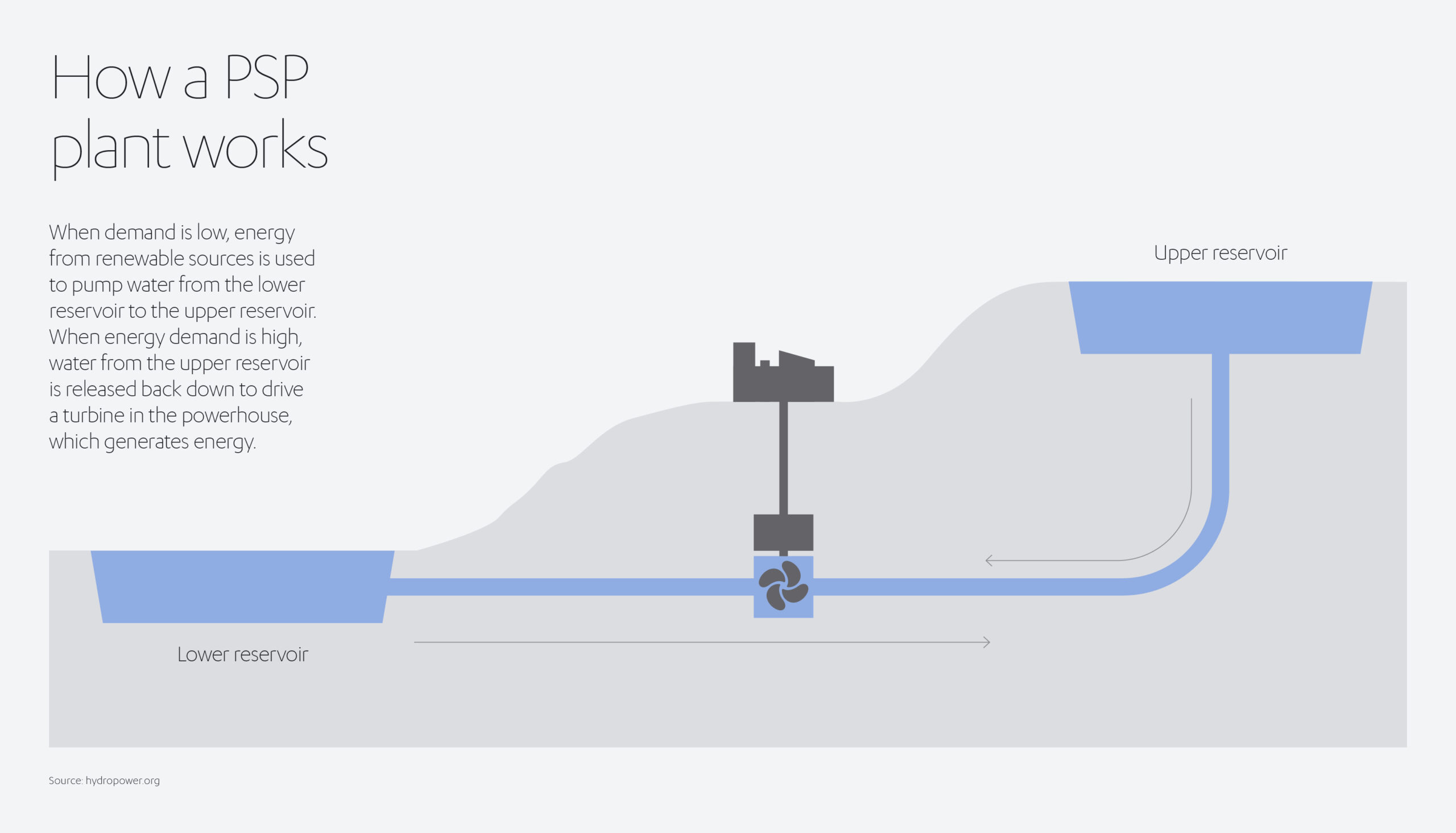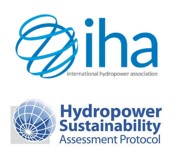Harnessing hydropower
Hydropower – the power generated by moving water – is increasingly being seen as one of the most promising solutions to two of our society’s biggest challenges: climate change and energy security.

“With sustainable hydropower, we can make net zero goals a reality. We can create a renewable and resilient energy system,” writes Erik Solheim, former UN diplomat and Norwegian Minister of Environment and International Development[1].
Backing the campaign to promote hydropower in meeting the target of net zero carbon emissions, Solheim argues that replacing coal and other fossil fuels – and achieving energy security – will mean embracing all green energy sources, rather than choosing between different technologies.
The argument put forward by Solheim and many others is that hydropower, the world’s largest producer of renewable energy, already makes an enormous contribution to emissions reductions, avoiding up to four billion tons of additional greenhouse gas emissions in comparison to coal.
Yet it could achieve so much more. Not only in terms of potential hydropower sites around the world, but also in terms of the know-how and technology to develop water resources sustainably, so hydropower could play an integral role in enabling net zero.
Fueling growth
Hydropower itself is ancient. The Greeks used water wheels for grinding wheat into flour more than 2,000 years ago, while the Egyptians used Archimedes water screws for irrigation during the third century BC.

The evolution of the modern hydropower turbine began in the mid-1700s when a French hydraulic and military engineer, Bernard Forest de Bélidor, wrote the four-volume Architecture Hydraulique[2], which described the principles of engineering mechanics, mills and waterwheels, pumps, harbors, and sea works.
By the end of the 19th Century, many small hydropower plants were in operation generating electricity from moving water using turbines, with the USA at the forefront of hydropower design[3].
The USA also led the world in adopting hydropower by demonstrating just how effective it could be in meeting growing energy demand.
President Roosevelt’s New Deal of the 1930s supported the construction of several multipurpose landmark projects, such as the Hoover and Grand Coulee dams, so that by 1940 hydropower generated 40% of the country’s electricity generation.
From the 1940s to 1970s, state-owned utilities built significant hydropower developments throughout Western Europe, as well as in the former Soviet Union, North America and Japan.

Over the last decades of the 20th Century, Brazil and China became world leaders in hydropower, helping to grow their economies and develop energy-intensive industries, such as aluminum smelters and steelworks. By 2020, hydropower supplied one sixth of global electricity generation, the third-largest source after coal and natural gas, with a total capacity that has risen 70% globally over the last 20 years[4].

Hydropower plants
Today, there are numerous different hydropower technologies in operation around the world. Inland hydropower plants have three main types[5]. Run-of-river plants use the flow of water to drive generators. They normally provide a constant flow of energy but can only provide power broadly in line with the flow of the river because they do not store water for long periods.
The other two types of inland hydropower plant are more flexible. Hillside reservoirs store water that can be released to power turbines when necessary. Pumped-Storage Plants (PSP) are reservoirs that act as rechargeable water batteries: they pump water up to a reservoir when there is a surplus of power, when demand is low, and let it down when demand is high, driving a turbine to produce electricity in the process.
The energy storage capacity of a pumped hydro facility depends on the size of its two reservoirs; while the amount of power generated is linked to the size of the turbine. A facility with two reservoirs roughly the size of two Olympic swimming pools, and a 500–metre height difference between them, could provide a capacity of 3 megawatts (MW) and store up to 3.5 megawatt hours (MWh) of electricity. The International Energy Agency (IEA) forecasts that PSP will account for 30%, or 65 GW, of global hydropower capacity expansion up to 2030, significantly outpacing the storage capacity of traditional batteries[6].

The fourth type of hydropower is tidal and, again, it is nothing new. Tidal power has been used in watermills such as the Eling Tide Mill[7] – mentioned in the Domesday Book of 1068 –for hundreds of years. The principle is simple: when the tide comes in, it pushes open one-way gates and fills up the millpond, which is then released to power the water wheel when the tide turns and go out.
Tidal barrage[8] and tidal lagoon schemes work the same way, trapping water at high tide and then releasing it through defined channels that carry it through a turbine. Tidal stream generators work like wind turbines, so that the tide pushes the rotors of a turbine as it flows in and out. Dynamic tidal power schemes depend on long walls that jut out at a right-angle to the shore. As the tide passes the wall, it is trapped on one side or the other, creating head. This high water is only allowed to flow past the wall by flowing through defined paths that carry it past generators.
Contributing to net zero
The feature that makes hydropower so attractive is that it relies on an inexhaustible source of power: gravity. Water is simply the medium through which the power of gravity is harnessed. This makes hydropower an ideal complement to solar PV and wind in an electricity grid that is trying to wean itself off fossil fuels and meet the target of net zero carbon emissions.
Most hydropower plants can respond very quickly to changes in demand, increasing or reducing their output swiftly in comparison with other power plants such as nuclear, coal and natural gas. Consequently, hydropower can step in when the sun does not shine and the wind stops blowing, making up for any shortfall from solar or wind power sources.
This potential to supply large amounts of low-carbon electricity on demand makes hydropower a key asset for building secure and clean electricity systems. The IEA’s report, Net Zero by 2050: A Roadmap for the Global Energy Sector[9], identifies hydropower as one of the “largest sources of low-carbon electricity today” and “an essential foundation” for the transition to net zero.
 According to IEA figures[10], hydropower plants account for almost 30% of the world’s capacity for flexible electricity supply, but they have the potential to provide even more.
According to IEA figures[10], hydropower plants account for almost 30% of the world’s capacity for flexible electricity supply, but they have the potential to provide even more.
The IEA report, though, gives mixed news.
On the plus side, around half of hydropower’s economically viable potential is untapped[11]. The potential is particularly high in emerging economies and developing economies, reaching almost 60%. But plants in both North America and in Europe are, on average, more than 45 years old. With an expected operational life of 55 years, major investment in needed now to keep these plants producing renewable energy efficiently. In fact, modernization work on existing plants is forecast to account for almost 90% of total hydropower investment this decade – but even this might not be enough.

Politics of hydropower
One of the major difficulties of hydropower projects at both local and international level is finding an equitable compromise that benefits everyone. All too often there are obvious winners and losers. For example, the Itaipu Dam that straddles Brazil and Paraguay was the price that Paraguay paid to end the Brazilian invasion of 1965[12]. It created a lake so big that it submerged the Guairá Falls, previously the highest in the world. Under the terms of the Itaipu Treaty, Paraguay must sell to Brazil every megawatt of its half share of the energy produced that it does not consume itself – sales to third countries are prohibited.
Constructing the dam and the 14,000 MW hydropower plant meant that the Paraguayan government had to take out a US$ 2 billion loan it could ill-afford and will only repay in 2023.

China’s enthusiasm for hydropower has led to its building massive dams, not only on rivers such as the Yellow and the Yangtze that flow only in China, but also on others, such as the Mekong and the Brahmaputra, that pass through several more countries on their way to the sea[13]. There are already 11 Chinese dams on the Mekong – and there are plans for eight more. During a drought in 2021, the river ran so low that Cambodia had to turn off a large hydropower plant, while the altered flow has caused saltwater to contaminate the Mekong delta, the breadbasket of Vietnam, and decimated Cambodian fish stocks.
Environmental considerations have also led some countries to question whether to launch new hydropower projects at all. For instance, the Chinese-financed 90-MW Erdenburen plant in Mongolia has faced opposition from groups concerned about the mega-project’s potential to damage the Ramsar wetlands and disrupt indigenous communities. Meanwhile, in November 2022, the US Federal Energy Regulatory Commission gave orders to decommission four dams straddling the California-Oregon border – the largest dam removal undertaking in US history – to restore habitat for endangered fish[14]. The aim is to improve the health of the Klamath River, the route that Chinook salmon and endangered coho salmon take from the Pacific Ocean to their upstream spawning grounds, and from where the young fish return to the sea. The power utility PacifiCorp is contributing US$ 200 million toward dam removal, while California voters approved a bond measure for the state to provide an additional US$ 250 million[15].
 Concerns over issues such as these, plus the environmental and social impacts of dam building, led to the International Hydropower Association (IHA) developing the Hydropower Sustainability Assessment Protocol (HSAP).
Concerns over issues such as these, plus the environmental and social impacts of dam building, led to the International Hydropower Association (IHA) developing the Hydropower Sustainability Assessment Protocol (HSAP).
The HSAP defines good and best practice at each stage of the life cycle of a hydropower project across 24 environmental, social, technical and economic topics[16], providing a clearer understanding of the overall sustainability of a project.
It also includes cross-cutting themes that feature in multiple topics, such as gender issues and human rights.
One of the ironies of hydropower is that despite its vast potential, it is probably the renewable energy source most impacted by the effects of climate change, particularly in terms of weather patterns. Droughts across many parts of Europe in 2022, for example, saw several run-of-river hydropower plants starved of water and reservoirs not filled to their usual levels. As a result, the amount of energy generated by Europe’s hydro plants in 2022 was significantly below that achieved in 2021[17].
The picture in the USA is similar, particularly in the south-west, which is suffering from its harshest drought for over 1,000 years, according to a paper in Nature Climate Change[18]. In August 2022, the federal government announced another round of water cuts for Nevada and Arizona.
About 32% of America’s renewable energy came from hydropower in 2021, 44% of which was generated in California, Oregon and Washington, but the drought is already having its effect. In 2021, California shut down a power station at Lake Oroville, one of the state’s largest reservoirs, when water levels fell below what is needed for electricity generation. Overall, California’s hydropower generation has fallen by 62% since 2019, with the state turning to natural gas to make up the shortfall.
Eyes on innovation
On the positive side, there have been developments in hydropower technology that might mitigate the effects of climate change and make use of existing infrastructure. In the USA, the Office of Energy Efficiency and Renewable Energy[19] is funding research into low-head hydropower that would enable existing non-powered dams, canals, and conduits to generate electricity. ‘Low-head’ simply means hydropower plants that operate with a change in elevation ranging from 2 to 20 meters.

For example, Percheron Power[20] has developed and tested a next-generation Archimedes hydrodynamic screw turbine constructed from composite materials using an advanced manufacturing method called light resin transfer molding. This has lower production costs, waste and emissions compared to steel and, even though they have the same structural properties as steel, composite turbines are 25%‒30% lighter in weight.
The composite blades are gel-coated while in the mold so they do not need primers or corrosion resistant-paints and they can be replaced individually, unlike a steel turbine blade.
In another example, Natel Energy designed, built and commissioned a reliable powertrain for the Schneider Linear hydroEngine™. By reducing capital and maintenance costs, this powertrain enables the development of new low-head hydropower capacity —achieving levelized-cost-of-energy savings of around US$ 2 per megawatt hour[21].
Financing the future
Yet technological innovation can only go so far. Although technological advances have made hydropower generation more efficient and flexible, average investment costs have largely remained unchanged. The IEA would like to see more financial innovation. It argues that the role hydropower can play in boosting security of electricity supply is not sufficiently recognized and remunerated in advanced economies. Developing economies, on the other hand, need access to affordable financing to develop sustainable hydropower.
For advanced economies to make the most of hydropower, governments need to reduce the risks associated with investment through measures such as state guarantees, long-term contracts and other measures to raise remuneration certainty[22]. In Europe and North America, the majority of the most economical sites for large projects are already developed, yet new small hydro plants can also provide an important source of low-carbon generation, while enabling the integration of additional PV and wind capacity[23]. In the case of emerging and developing economies, the IEA argues that hydropower needs innovative business models such as public-private partnerships that allocate risk to the appropriate stakeholder[24].

Supporters of hydropower are justifiably convinced that it has the potential to improve energy security, cut carbon emissions and boost prosperity, but geo-political challenges and a lack of clear financial incentives combine to hinder its growth.
Malcolm Turnbull, former prime minister of Australia and board member of the International Hydropower Association, said of hydropower: “The key barrier to its global deployment is a lack of appropriate market mechanisms of the type that have enabled wind and solar to be installed at scale. We already have all the technologies we need to deliver 100% decarbonized grids. What we need is the political will.”[25] As the global journey towards net zero picks up pace, hopefully the political will is not too far behind.
At Abdul Latif Jameel, we know that decarbonizing the energy sector must be a priority for us all. Whether harnessing the power of water or unleashing the potential of the sun, the future of energy is resoundingly renewable. That’s why, through our flagship renewable energy business FRV and their energy innovation specialist and incubator FRV-X, we’re now active across 18 countries. Over the next four years, FRV plans to invest more than US $1.5 billion in assets to double its total installed capacity of projects worldwide, from 2 GW at the beginning of 2021 to 5 GW by 2025.

Deputy President & Vice Chairman
Abdul Latif Jameel
While its main focus will continue to be large-scale solar PV, battery storage and wind projects, FRV is also expanding the scope of its activities to encompass all clean power solutions and vertically expanding its activities by increasing its commercial focus to end customers.
“No single renewable energy source can possibly provide all the answers to the net zero conundrum.
But hydropower technology has the potential to be at the heart of the energy transition, using an almost limitless source of energy – water – to power a more sustainable future for our society, and for our planet,” says Fady Jameel, Deputy President and Vice Chairman of Abdul Latif Jameel.
[1] https://www.hydropower.org/blog/with-hydropower-we-can-create-a-renewable-and-resilient-energy-system
[2] https://www.energy.gov/eere/water/history-hydropower
[3] https://www.hydropower.org/blog/blog-hydropower-growth-and-development-through-the-decades
[4] https://iea.blob.core.windows.net/assets/83ff8935-62dd-4150-80a8-c5001b740e21/HydropowerSpecialMarketReport.pdf
[5] https://www.economist.com/the-economist-explains/2022/12/05/can-hydropower-help-ease-europes-energy-crisis
[6] https://oxfordbusinessgroup.com/news/storage-technology-could-elevate-hydropower-role-global-energy-transition?utm_source=Oxford%20Business%20Group&utm_medium=email&utm_campaign=13441313_ESG_Hydropower_September%201&utm_content=eu-september-2022&dm_i=1P7V,803DT,QZEKVW,WQ8U8,1
[7] https://www.elingexperience.co.uk/a-brief-history
[8] http://tidalpower.co.uk/tidal-power-schemes
[9] https://iea.blob.core.windows.net/assets/7ebafc81-74ed-412b-9c60-5cc32c8396e4/NetZeroby2050-ARoadmapfortheGlobalEnergySector-SummaryforPolicyMakers_CORR.pdf
[10] https://www.iea.org/reports/hydropower-special-market-report/executive-summary
[11] https://iea.blob.core.windows.net/assets/83ff8935-62dd-4150-80a8-c5001b740e21/HydropowerSpecialMarketReport.pdf
[12] https://www.economist.com/the-americas/2019/08/22/a-secret-hydropower-deal-with-brazil-causes-a-political-crisis-in-paraguay
[13] https://www.economist.com/leaders/2020/05/14/if-china-wont-build-fewer-dams-it-could-at-least-share-information
[14] https://www.theguardian.com/environment/2022/nov/17/us-dam-removal-endangered-salmon-klamath-river
[15] https://www.economist.com/united-states/2021/07/08/in-the-pacific-north-west-hydroelectric-dams-are-being-removed
[16] https://www.hydropower.org/publications/hydropower-sustainability-assessment-protocol
[17] https://www.economist.com/the-economist-explains/2022/12/05/can-hydropower-help-ease-europes-energy-crisis
[18] https://www.economist.com/the-world-ahead/2022/11/18/americas-reservoirs-are-drying-up
[19] https://www.energy.gov/eere/water/hydropower-technology-development#LowHeadHydropower
[20] https://www.energy.gov/eere/water/articles/21st-century-archimedes-screw-new-materials-and-manufacturing-techniques-enable
[21] https://www.energy.gov/eere/water/hydropower-technology-development
[22] https://iea.blob.core.windows.net/assets/83ff8935-62dd-4150-80a8-c5001b740e21/HydropowerSpecialMarketReport.pdf Page 26
[23] https://iea.blob.core.windows.net/assets/83ff8935-62dd-4150-80a8-c5001b740e21/HydropowerSpecialMarketReport.pdf Page 30
[24] https://iea.blob.core.windows.net/assets/83ff8935-62dd-4150-80a8-c5001b740e21/HydropowerSpecialMarketReport.pdf Page 13
[25] https://www.economist.com/letters/2022/07/14/letters-to-the-editor





 1x
1x

 Added to press kit
Added to press kit


